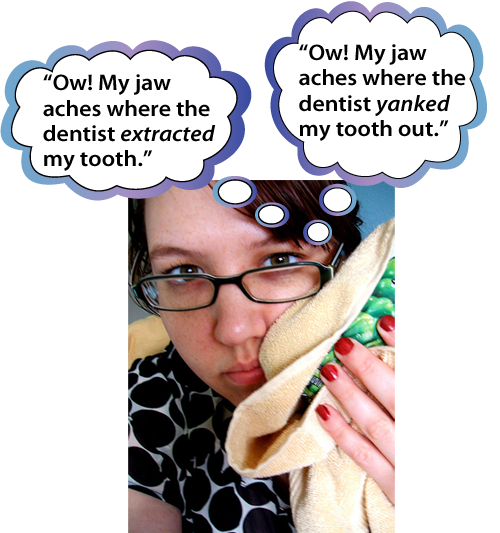Look at the illustration below. The girl is holding a frozen bag to her sore jaw because the dentist has removed a tooth. In her first thought, “extracted” is the word that the dentist would use to describe the procedure that involves removing a tooth. In her second thought, “yanked” is the way you might describe what the dentist did when he removed your tooth based on the way it felt when he was removing it. The first definition is the denotative meaning; the second one is the connotative meaning that your emotions give to the word.
Knowing that words have connotative meaning means the difference between getting money from your Great Aunt Ethel when you fondly describe her as curious and getting nothing when you talk about her as a busybody. Though curious could be connotatively understood to mean busybody, it’s a nicer way to say nosey or busybody. The emotion you feel when you use the word curious is more positive than when you use the word busybody. Knowing the connotative value of words is important in reading and writing because, as you can see, it helps you understand the tone of a something you’re reading.

Source: Toothache, kayepants, Flickr

- House, home, residence
- Thin, slender, skinny, lean, beanpole
- Unattractive, plain, dull, ugly
- Reporter, journalist, broadcaster, paparazzi
Residence doesn’t carry as much emotional meaning as “house” and “home.” “Residence” is the word that’s on forms that you fill out. While “house” is still not a warm and fuzzy word, it does bring to mind a building and place, whereas “residence” may only cause you to think about your address. “Home,” on the other hand, might make you feel something good or bad related to how you actually live and the times spent with family and friends. “Home” evokes a much more personal and emotional response and has a different connotation than “house.”
For all of the rest of the answers, you can make a case that many of them carry emotional meaning, except for “reporter” and perhaps “unattractive” and “thin,” which are typically used denotatively in what you read. The question to ask is, what connotative meanings do the words have? In your family which words would be used to describe someone who is underweight? Would it be thin? Slender? Lean? Or beanpole? Why would you or your family choose one word over another?
This lesson is about how words can have emotional connections for readers. Words and their meanings are important because you need to be able to communicate your ideas and feelings concisely. When you want to use the most concise word, you most often use the word’s denotation. An example of denotative meaning is car (i.e., I’m driving my car to the store). It’s easy to remember what the denotative meaning of a word is because “denotation” and “dictionary” both begin with the letter “d.” Two words that also mean “car” but have more emotional meanings might be “ride” or “wheels.”
Other words that authors use have indirect, personal meanings. These words can affect readers in different ways. The term for this kind of meaning is connotation. An example of connotative meaning is the word “blue,” as in “I’m feeling blue.” If you were using the word denotatively and said, “I’m feeling blue,” your friends would wonder why your skin was actually turning blue! It’s easy to remember the meaning of connotation because “connection” and “connotation” both start with the letter “c.” Here’s another way to understand denotation and connotation using the word “snake.”
Denotation = Dictionary (dictionary definition of a word)
- Snake: a long limbless reptile that has no eyelids, a short tail, and jaws that are capable of considerable extension and venomous bite
Example: Be careful hiking during the day; snakes may be out looking for water.
Connotation = Connection (emotional associations attached to a word)
- Snake: a treacherous or deceitful person
Example: Brutus is a snake in Julius Caesar’s circle of friends.
Now that you have a basis for understanding denotation and connotation, here are some questions to ponder as you study this lesson:
- How can knowing a word’s connotative meaning help when reading nonfiction texts?
- How can knowing a word’s connotative meaning help when reading a short story, poetry, or dramatic text?
Knowing the difference between a word’s connotation and denotation when reading can help you understand the author’s purpose. As Mark Twain said, “The difference between the right word and the almost right word is the difference between lightning and a lightning bug.” Connotation and denotation are a part of language, and knowing about them can help you understand not only the author’s purpose, but also the author’s attitude about what was written.